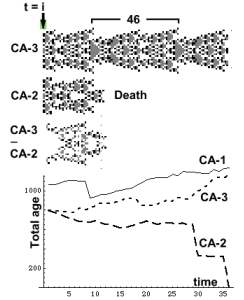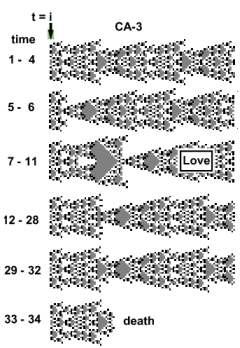 |
Information retrieval
The previous experiment
showed that information storage is still cumbersome. On the other hand,
information retrieval is
simpler. We start with two synchronized oscillating CA with a period
of 46 time units. The experiment starts
when both reach state-i, and CA-2
starts losing age at a rate
of one age increment per step. Cells with less age die sooner than cells
with more age. By t-35 all cells
are dead. The third figure under CA-2 depicts the loss of cells with
time. CA-2 differentiates with time.
 |
 |
In CA-2 context,
each of the 35 states leads to its death. It is an apoptotic
process. Yet when copied
to CA-3, only states 34 and 35 kill it. In the context of CA-3, all other states acquire a different meaning.
The two CA vary in their age structure.
Memory generation
This simple memory does not require any storage device!
Suppose that CA-3 wants to recall state-7, the state of love. Remember that
CA-3 cycles through 46 states. When arriving at state-i , it stops CA-2 aging, waits seven more time units,
copies the required state and falls in love. Later on CA-2 disappears, which
saves resources. CA-3 makes love for a while until being replaced with a zygote which later on
assumes the 46 period cycle.
A retrieved information is useful if it leads to
a solution.
Recall is a perturbation with four kinds of outcome:
1. No change
(States 1-4)
2. A new
stationary oscillator. (All states except 34 and 35)
3. Transient
oscillations (States
7-11)
4. Death
(States 34-35)
Setup
nca3 zygote -> effect[no,1000]; go[70]; go[50];
go[50] storeparams; restoreparams; donate[2, 2]; If[j== mm, a[[3]] = a[[2]]];
go[100];